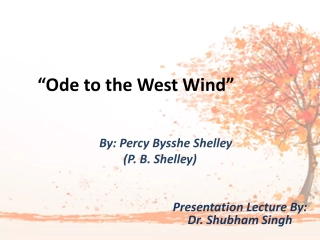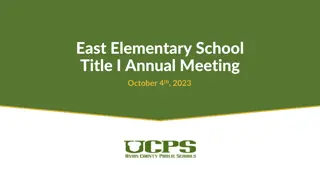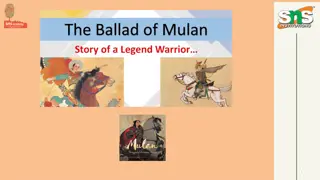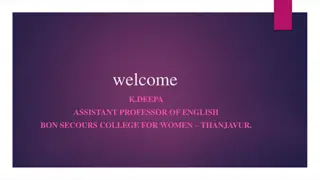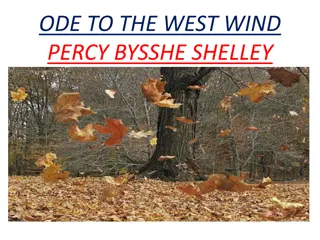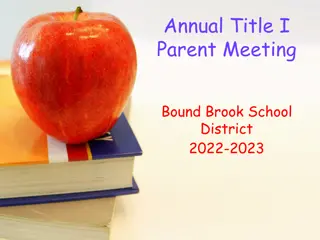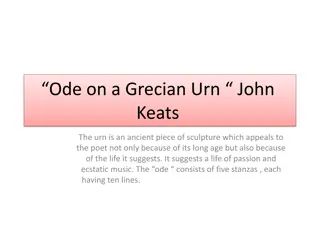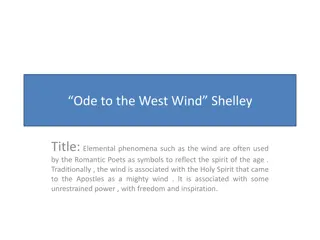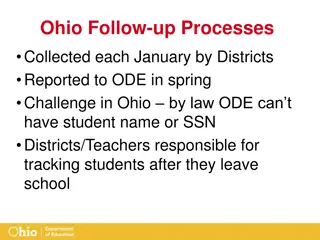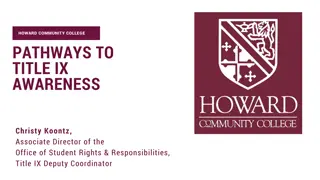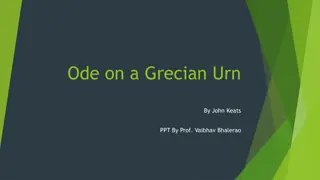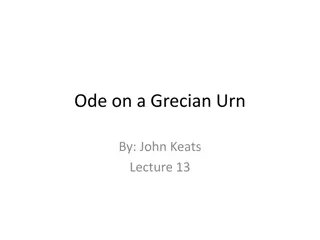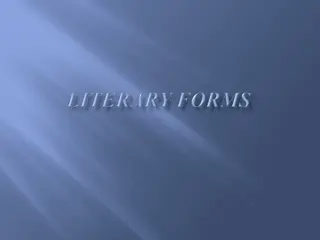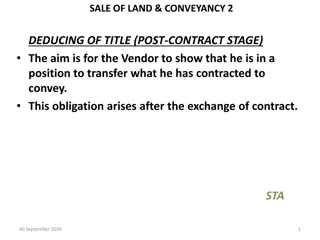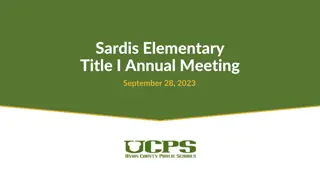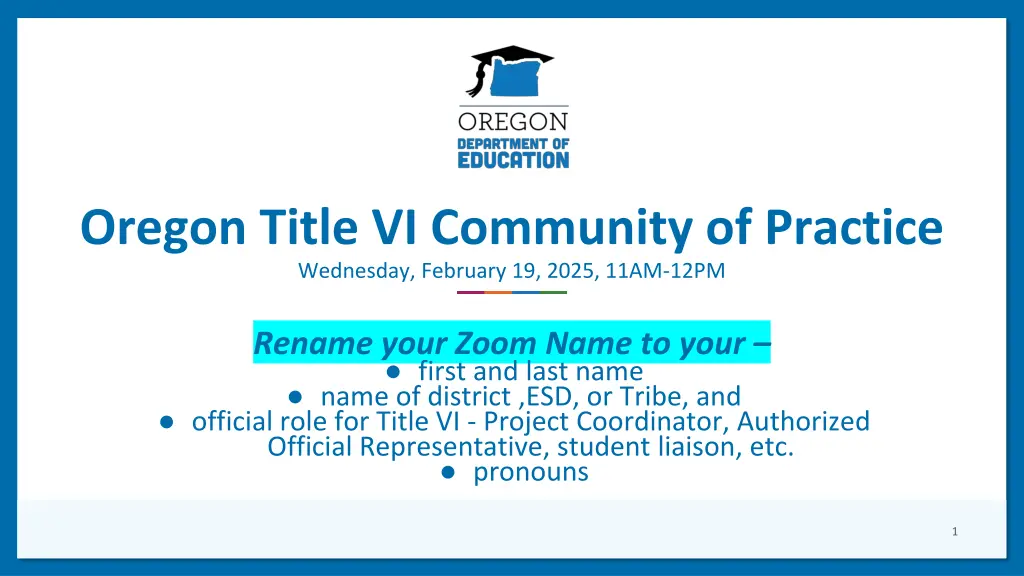
Oregon Title VI Community of Practice Meeting Highlights
Explore the insights from the Oregon Title VI Community of Practice meeting, featuring updates on EASIE, Formula Grant Timeline, graduation data, and more. Learn about resources shared by ODE for supporting immigrant, LGBTQ2SIA+, and gender expansive students in Oregon's K-12 public schools.
Download Presentation

Please find below an Image/Link to download the presentation.
The content on the website is provided AS IS for your information and personal use only. It may not be sold, licensed, or shared on other websites without obtaining consent from the author. If you encounter any issues during the download, it is possible that the publisher has removed the file from their server.
You are allowed to download the files provided on this website for personal or commercial use, subject to the condition that they are used lawfully. All files are the property of their respective owners.
The content on the website is provided AS IS for your information and personal use only. It may not be sold, licensed, or shared on other websites without obtaining consent from the author.
E N D
Presentation Transcript
Oregon Title VI Community of Practice Wednesday, February 19, 2025, 11AM-12PM Rename your Zoom Name to your first and last name name of district ,ESD, or Tribe, and official role for Title VI - Project Coordinator, Authorized Official Representative, student liaison, etc. pronouns 1
Everyone - Greet one another in your tribal language or in the language of the local tribe(s). Then, drop into the chat what you find yourself doing on a snowy day OR the most beautiful place to be when it snows. v 2
Introductions and Role Esteemed Guest - Assistant Superintendent, Office of Indian Education, Oregon Department of Education April Campbell, citizen of the Confederated Tribes of Grand Ronde Oregon Office of Indian Education Title VI Lead - Stacy Parrish, Education Program Specialist II, Proud Member of the Klamath Tribes (Yahooskin Paiute) 3 Oregon Department of Education
Todays Agenda - In Community with April, EASIE Updates, the Formula Grant Timeline, & Graduation and Dropout/Pushout Data Upcoming EASIE Part 2 Window - Intentional Pre- Planning Work LEAs and LEA-C - Option 1 or Option 2 for Section 6119 Compliance Community of Practice Shared Folder - Update it and the Contact List Regularly 4 Oregon Department of Education
Resources Shared by ODE Sign up for ODE GovDelivery communications HERE. Watch Protecting Oregon Values - YouTube by Governor Kotek Read Oregon's Continued Commitment to Youth & Community - Stay Focused. Stay Strong Reference NEW: Supporting All of Oregon s Students: Guidance for protecting and upholding the rights of immigrant students in Oregon s K-12 public schools Oregon Public Education and Immigration Enforcement FAQ Department of Justice: Sanctuary Promise Supporting Gender Expansive Students: Guidance for Schools Every Student Belongs Guidance LGBTQ2SIA+ Student Success Plan and ODE s LGBTQ2SIA+ Resources webpage 5 Oregon Department of Education
Quick Updates from the EASIE Website Important Links from EASIE Communities Site - Have a list of technical questions? Part I of the application consists of selecting the applicant type, entering the Indian and All student count and application cycle. EASIE Title VI Office Hours with the US Department of Education - Call 866-731-4711 or email OIE.EASIE@ed.gov to get the link for the monthly office hours. The sign up link on this website remains broken. EASIE Part 1 Paper Document EASIE Part 1 FAQs EASIE ED 506 Form Webinar SY 2021-22 UPDATED: EASIE Part I Webinar FY 2024-25 Your go-to for Technical Assistance is either the Partner Support Center at 866-731-4711, or Greg Hindsley, US Department of Education OIE Formula Team for Oregon at 202-453-5795 or gregory.hindsley@ed.gov 6 Oregon Department of Education
Quick Updates from the EASIE Website Important Links from EASIE Communities Site - What Year Are We in Our Application? Part 2 of the application provides applicants their initial allocation based on the Indian student count total submitted under Part I. Part II also enables applicants to select the objectives, corresponding activities/services, and data sources for measuring progress towards the objectives and build a realistic program budget. Navigate to the US Department of Education Office of Indian Education website. Scroll down until you see the document titled, FY 2024 OIE Formula (Title VI A) Awards with Indian Parent Committee Approval Form Public Hearing Meaningful Collaboration EASIE Part II Paper Form EASIE Part II Frequently Asked Questions EASIE Part II Applicant Checklist ISC, Award Amounts, and NCES IDs (updated 10/2/24) . Sort the spreadsheet to filter only Oregon awardees. Find your LEA, LEA- C, or tribe. Review the information. 7 Oregon Department of Education
General Formula Grant Timeline To Do List - Make sure the Public Hearing is scheduled, as well as Meaningful Collaboration Deep dive into data in preparation for EASIE Part II Public Hearing and Meaningful Collaboration must be held before Part II closes -ALL LEAs and LEA-Cs send final EASIE Part II app and IPC Approval form emailed to ODE -EASIE PART II Submission Deadline to US Department of Ed May 9 -OPTION 2 LEAs and LEA-Cs receive comments back May 13-21 -EASIE APR for FY 23-24 opened Sept. 9 -Indian Parent Committee Start of Year Outreach -District and School-Wide Registration Norming - 506 -EASIE PART I Closes March 7 -Integrated Guidance Opens March 1 - NEW March 31 EASIE PART II Application Available -Native American Heritage Month -Winter Solstice, Dec 21 MAY SEPTEMBER MARCH NOVEMBER/DECEMBER JANUARY/FEBRUAR Y APRIL OCTOBER -EASIE APR for FY 23-24 closed October 11 -Indigenous Peoples Day, Monday Oct 14 -OPTION 1, April 7-14, LEAs and LEA-Cs, Applications submitted to ODE for Comments -Applications returned with Comments, April 15-21 -April 30 Integrated Guidance Window Closes -EASIE Part 1 Opens February 3rd 8 This is a general visual of the Title VI school year timeline. All LEAs and LEA-Cs should adhere to all published DOE timelines to plan their efforts.
Graduation and Dropout/Pushout Data is Now Public Definitions - A graduate - Student who earned an Oregon Regular Diploma, participated in a Post Graduate Scholars program, or received an Oregon Modified Diploma. Dropout/Pushout - A student who withdrew from school and did not graduate or transfer to another school that leads to graduation is included in this dropout/pushout data. Where to Access It ODE s Cohort Graduation site Dropout/Pushout Rates in Oregon s Schools site Suppressed and Unsuppressed Data State suppression rules for all data published publicly. Rules for a data set can be found in a Notes tab. You will need to seek permission from District leadership to review the unsuppressed data (i.e. all data, regardless of cohort size ), as it is a FERPA violation for this data to be published or available to the public. Oregon Department of Education
Four Year Graduation Cohort Highlights In the statewide news release from ODE Class of 2024 Overcame Historic Obstacles to Graduate at Second-Highest Rate in Oregon, celebrations were shared on the statewide graduation rate for the class of 2024 at 81.8%. Those graduates began high school during remote learning of the pandemic, ending their 9th grade year with only 73.6% of them On-Track. American Indian and Alaska Native students had a four year cohort graduation rate of 70.1%, reflecting a 1.9% increase from the previous graduating class. This is quite an achievement, as 57.6% of AI/AN students were On-Track after their 9th grade year, demonstrating their resilience to overcome the challenges of the pandemic. Six districts receiving the Tribal Attendance Promising Practices grant had an average rate of 72%, surpassing the state AI/AN average. Four of those same TAPP districts AI/AN graduation rate exceeded the statewide overall average. North Bend, Pendleton, Jefferson County, and Willamina The average graduation rate for districts receiving the benefits of a Title VI program was 62.5%, reflecting a significant gap even from the state AI/AN average. However, we cannot lose sight of the fact that 183 AI/AN students failed to graduate last year, with only 35 of those Native young people continuing their enrollment to a 5th year of schooling. Oregon Department of Education
Dropout/Pushout Data Definition: Dropout/Pushout - A student who withdrew from school and did not graduate or transfer to another school that leads to graduation is included in this dropout/pushout data. Statewide the Dropout/Pushout rate is 3.6%; however, the AI/AN rate is 7.8% the highest out of all student groups. The Dropout/Pushout rate for AI/AN students in alternative schools is 17.5% for AI/AN students; while AI/AN rate for students in fully virtual programs is 19%. Last school year alone, 173 American Indian and Alaska Native dropped out or were pushed out of school. Oregon Department of Education
Critical Lens of Analysis Our Native students are overrepresented in Alternative and Online schools. When analyzing data, look at how AI/AN students did at the local high school(s) and then the alternative or local online schools. Ask: What do you notice? What do you see? Regardless of cohort size, losing any of our AI/AN students has negative implications on tribal sovereignty. What will you say when someone says, Well, the data looks bad, because there were only five Native students represented in that data. Oregon Department of Education
Pre-planning for EASIE Part 2 The Application and then Greater Planning Oregon Department of Education 13
Backwards Plan from the Legislation (YES!) Backwards Plan from the dreams tribes have for their youth. (EVEN BETTER!) EASIE Part 2 Application The application itself is quite slim. There are two places for a district to write original content (2000 character limit description of a comprehensive program and a professional development table), with most of the application comprised of drop down menus. More Importantly . Supplement, not supplant: What does it look like in your district, outside of Title VI efforts, to - 1. Meet the unique cultural, language, and educational needs of such students; and 2. Ensure that all students meet the challenging State academic standards. Title VI Part A Indian Education Legislation 14
Title VI Comprehensive Indian Education Program and Proposed Objectives SEA-Administered Federal Title Programs: v 15
EASIE Part 2 Application Window - March 31 to May 9 Year 4 of 4 of the Multi-Year Application Bethel School District Coquille School District #8 David Douglas School District Harney County SD #3 Lincoln County School DIstrict North Bend School District #13 Powers School District #31 aka Coos County 31 Rainier School District #13 Salem Keizer Public Schools Willamina School District 30 J Single Year Applications Beaverton School District Clatskanie School District Corvallis School District Klamath Falls City Schools Multnomah School District No. 1 North Clackamas School District North Wasco County SD 21 Scappoose School District Southern Oregon Education Service District 16
How Can We Approach EASIE Part II Planning Beyond the Status Quo? 1. Call everyone to the table. District leaders Other district staff Educators Students Families Tribal Community (You get it.) 1. Dig into data to get a holistic picture of Native student success. Use protocols. Use norms. (The average person seems inherently terrified of spreadsheets and most educators are not well-equipped to analyze data.) 1. Backwards plan from legislation as a baseline. 17
Dig into data to get a holistic picture of Native student success. Borrowed from the Toolkit . Key questions to understand a comprehensive picture of Native success - Student Data How many students in your district identify as AI/ AN? How many are from our tribe? What percentage of those students are on track as 9th graders to graduate in 4 years? How are our students being measured in terms of academic achievement and what are their scores? (Math, Reading, Native Language Proficiency perhaps) How many of our students have been identified as Talented & Gifted? How many of our students have an Individualized Education Plan (IEP)? Tribal Consultation Toolkit 2.1; State Requirement p. 31 18
Tribal Consultation Toolkit 2.1; State Requirement p. 26 Borrowed from the Toolkit . Continued - Key questions to understand a comprehensive picture of Native success How many of our students have been expelled or pushed out of your schools? How do the rates or percentages of AI/AN students compare to the entire school or district population? Programs and Curriculum Are you teaching Tribal History / Shared History curriculum in your schools? At what grade levels? How does the curriculum other than Tribal History/ Shared History, highlight and celebrate our tribal communities, our past and our present- day communities? Where in your curriculum is tribal sovereignty explained and celebrated? What are the attendance rates like for our students? What percentage are regular attenders? What percentage experience chronic absenteeism? Does your school district utilize specific attendance codes that honor AI/AN culture? How many of our students have had disciplinary referrals? Are you tracking rates of discipline among AI/AN students and determining how to best address disproportionate disciplinary rates by finding solutions to decrease expulsion, suspension, and pushout rates? 19
Tribal Consultation Toolkit 2.1; State Requirement p. 26 Borrowed from the Toolkit . Continued - Key questions to understand a comprehensive picture of Native success Is the language of our tribe present in any way or elevated or taught in your schools? What programs are available for AI/AN youth? Clubs, cultural events, etc Please describe the Career & Technical Education (CTE) opportunities for AI/AN students Which honors or college courses are offered in your school district (Advanced Placement, International Baccalaureate, dual enrollment, etc) and what is the representation of AI/AN students in those courses? How do you ensure equitable access to those programs? How many of our students attend after school programs? How many of our students are in alternative education programs? How many of our students participate in extracurricular activities (e.g., band, sports, debate) Staff How many AI/AN educators are there in the school district? What roles do they hold (e.g., teacher, administrator, paraprofessional)? 20
Borrowed from the Toolkit. Key questions to ask about the Integrated Guidance application - Tribal Consultation Toolkit 2.1; State Requirement p. 26 21
Section 6119 Compliance By March 21 - Please email me at stacy.parrish@ode.oregon.gov if your LEA or LEA-C will be selecting Option 1 or Option 2. This is non-binding and is only being used for internal planning purposes. 22 Oregon Department of Education
Option 1 Overview - Comments Before May 9 Why Choose this Option? The LEA or LEA-C s EASIE Part 2 application will be completed early in the EASIE Part 2 window, which includes obtaining full approval by the Indian Parent Committee and Meaningful Collaboration. The LEA or LEA-C would like comments on their application. The LEA or LEA-C would like to review comments and respond (which is NOT required) to them. Option 1 LEAs and LEA-Cs make the determination to submit copies to the agency during the submission window. ODE will provide comments on the applications, allowing an LEA or LEA-C an opportunity to respond to comments prior to the close of the EASIE Part 2 application window. Window for Applications to Be Submitted to ODE for Review - April 7-14 Window for Applications to Receive Comments by ODE and Returned to LEA - April 15-21 LEAs and LEA-Cs may respond to comments. This is not required - April 22 - May 9 Deadline for Applications to be Received by US Department of Education - May 9, 2025 A copy of the final EASIE Part 2 application will still need to be provided to ODE prior to closure of EASIE Part 2, May 9, 2025, via emailed PDF. 23 Oregon Department of Education
Option 2 Overview - Comments after May 9 Option 2 LEAs and LEA-Cs make the determination to not send copies of their application during the specified review window in April. ODE will still make comments on the application to be in compliance with Section 6119, but it will be after the EASIE Part 2 submission window closes on May 9, 2025. A copy of the final EASIE Part 2 application will be need to be provided to ODE prior to closure of EASIE Part 2, May 9, 2025 via emailed PDF. Window for Applications to Receive Comments by ODE and Returned to LEA if Option 2 is selected - May 13-21, 2025 Why Choose this Option? The LEA or LEA-C s EASIE Part 2 application will not be completed early in the EASIE Part 2 window and/or Meaningful Collaboration and Indian Parent Committee Approval has not taken place. The LEA or LEA-C would like comments on their application, but not prior to their submission of their application to the US Department of Education. The LEA or LEA-C would like to review comments and have an opportunity to respond (which is NOT required), albeit, after the EASIE Part 2 application window has closed. 24 Oregon Department of Education
Stacy Parrish, Education Program Specialist II Email - stacy.parrish@ode.oregon.gov Book an Office Hours - Book time with STACY PARRISH * ODE Text/Call - 971-208-0270 Contact Stacy Anytime I am available for things like Indian Parent Committee Training Advocating Up Help Data Analysis Work / Data Systems ESD Consortium Support Tribal Consultation and Improving Tribal Relations Help/Coaching 25
Section 6119 Compliance Initial Training for Awardees 26
Section 6119- Making Sense of Limited Guidance As a state educational agency, our scope of supporting Title VI Indian Education efforts is outlined in Sec. 6119 of the Title VI Indian Education legislation (p. 320) SEC. 6119. [20 U.S.C. 7429] STATE EDUCATIONAL AGENCY REVIEW. Before submitting an application to the Secretary under section 6114, a local educational agency shall submit the application to the State educational agency, which may comment on such application. If the State educational agency comments on the application, the agency shall comment on all applications submitted by local educational agencies in the State and shall provide those comments to the respective local educational agencies, with an opportunity to respond. v This expectation is also in the EASIE Part II FAQ document on page 29 11.4 Is there anything I need to do after my entity has certified my application? Yes, there are several remaining steps: Before Part II closes, download and save your application in PDF form. You should also save a signed copy of the program assurances which are available as a link from the certification screen. If you are an LEA, send a copy of your application to your SEA. Section 6119 of the ESEA requires that all LEA applicants send a copy of their Title VI Indian Education Formula Grant application to their SEA. If you do not have a specific Oregon Department of Education contact, mail it to the SEA (or the State superintendent) at the general address. 27
Priorities for ODE in Spring 2025 Goal - ODE hopes to achieve full compliance to Section 6119 - ODE will collect 100% of EASIE Part 2 applications from LEAs and LEA-Cs and will comment on 100% of them. High Level Summary Timeline - Last year we began phase 1 of getting into compliance with 6119. To date, 66% of non-tribal awardees are in compliance. (Here is the previous training about it from April 2024.) Who is Impacted by this? This only applies to EASIE Part 2. This requirement does not apply to tribes (see Section 6119). While working to achieve compliance, provide LEAs and LEA-Cs the option of when they knowingly will receive comments on their applications and opportunity to respond to them (see next slides). How are applications submitted? Via email to stacy.parrish@ode.oregon.gov How will districts leaders be notified about this? A GovDelivery (official communication to district and ESD superintendents) will be sent to Superintendents by the first week of March which will detail this information. 28 Oregon Department of Education
Priorities for ODE in SY24-25 - Continued Important Details An SEA s comments on a Title VI Indian Education Formula Grant application have no impact on the Department of Education s approval of an application. The EASIE Part 2 application has limited sections with written/original content. For SY24- 25, while the entire application will be reviewed, we will have a heightened focus on the following - Indian Parent Committee Approval Form Section 2 Part 2. Description of Comprehensive Program for American Indian/Alaska Native Students Section 2 Part 3. Coordination of Services Professional Development 29 Oregon Department of Education
Option 1 Overview - Comments Before May 9 Why Choose this Option? The LEA or LEA-C s EASIE Part 2 application will be completed early in the EASIE Part 2 window, which includes obtaining full approval by the Indian Parent Committee and Meaningful Collaboration. The LEA or LEA-C would like comments on their application. The LEA or LEA-C would like to review comments and respond (which is NOT required) to them. Option 1 LEAs and LEA-Cs make the determination to submit copies to the agency during the submission window. ODE will provide comments on the applications, allowing an LEA or LEA-C an opportunity to respond to comments prior to the close of the EASIE Part 2 application window. Window for Applications to Be Submitted to ODE for Review - April 7-14 Window for Applications to Receive Comments by ODE and Returned to LEA - April 15-21 LEAs and LEA-Cs may respond to comments. This is not required - April 22 - May 9 Deadline for Applications to be Received by US Department of Education - May 9, 2025 A copy of the final EASIE Part 2 application will still need to be provided to ODE prior to closure of EASIE Part 2, May 9, 2025, via emailed PDF. 30 Oregon Department of Education
Option 2 Overview - Comments after May 9 Option 2 LEAs and LEA-Cs make the determination to not send copies of their application during the specified review window in April. ODE will still make comments on the application to be in compliance with Section 6119, but it will be after the EASIE Part 2 submission window closes on May 9, 2025. A copy of the final EASIE Part 2 application will be need to be provided to ODE prior to closure of EASIE Part 2, May 9, 2025 via emailed PDF. Window for Applications to Receive Comments by ODE and Returned to LEA if Option 2 is selected - May 13-21, 2025 Why Choose this Option? The LEA or LEA-C s EASIE Part 2 application will not be completed early in the EASIE Part 2 window and/or Meaningful Collaboration and Indian Parent Committee Approval has not taken place. The LEA or LEA-C would like comments on their application, but not prior to their submission of their application to the US Department of Education. The LEA or LEA-C would like to review comments and have an opportunity to respond (which is NOT required), albeit, after the EASIE Part 2 application window has closed. 31 Oregon Department of Education
The Bigger Why - Looking Ahead As codified into law in the American Indian and Alaska Native Student Success Plan, the Office of Indian Education has an obligation to our AI/AN Advisory Community and to the Government to Government Education Cluster, to uplift Objective 3 of our AI/AN SSP. This requires us as an SEA to have comprehensive knowledge and synthesis of all Title VI formula grant applications submitted by LEAs and LEA-Cs in order to uplift our AI/AN SSP Plan Goals The current AI/AN SSP can be found here - American Indian and Alaska Native Student Success Plan (AI/AN SSP) 32 Oregon Department of Education
Community of Practice Shared Drive Please bookmark the link to the folder dropped in the Chat. We will not be posting it here, because these slides are shared publicly. Oregon Department of Education 33
Step 1 - Open the circled document. Read the directions. Step 2 - Fill out the Contact List first. This list is not public, but for internal use. Step 3 - Contribute to the CoP tab as much or little as you like! v 34 Oregon Department of Education

